List of construction machinery and construction equipment
Construction machines, also known as construction equipment, are stationary, semi-mobile or mobile machines that are driven by internal combustion engines or electric motors and with which building materials are processed, auxiliary construction materials are transported and construction tasks are carried out. They are used both in the main construction and ancillary construction trades . The construction equipment list used in the construction industry for the calculation of construction services contains a comprehensive directory of construction machinery and equipment. Many construction machines can not only be assigned to the construction industry because, in addition to their use in the construction industry, they are also used in the extraction industry ( mining or open-cast mining ), in agriculture , in landfill operations and in other branches of industry.
This list of construction machines and construction equipment gives an overview of the variety of construction machines and construction equipment of the present and names their typical areas of application. The development history of individual construction machines is explained in the respective article. Small appliances, auxiliary construction materials ( formwork and scaffolding ) or tools as well as track construction equipment and hydraulic engineering vehicles are not part of this list. Mining machines , such as bucket wheel excavators , are also not mentioned in the list.
classification
Earthmoving equipment
Earthworks are used to loosen, load, transport, install and compact earth masses or bulk materials over short distances. For work in earthworks , the devices are equipped with various trolleys and attachments . The type of construction depends on the soil material and its solvability. Furthermore, the conveyor route and the load-bearing capacity of the route influence the choice of machine. Some devices can be used universally, so that their use extends beyond earthworks to other areas of application. Basically, a distinction is made between stationary, mobile and flat and suction excavators.
Stand excavators do their main work, loosening and loading soil, largely in one place. The machine moves independently of this. Conveying processes are only economical over very short distances, since the travel speed and the conveying quantity are low. As a rule, there is also no transport in the sense of a process of goods, rather these are moved or pulled using the attachment tools.
| Device type | description | image |
|---|---|---|
| Hydraulic excavator | Hydraulic excavators are available in many different sizes and performance classes. With different undercarriages ( caterpillar , wheeled or two-way undercarriage ) and diverse work equipment, this device is suitable for almost every type of terrain and construction task. The device consists of an undercarriage with the chassis and a swiveling uppercarriage with the driver's cab and the work equipment (boom with an attachment, for example with a digging vessel). |

|
| Dragline excavator | Cable excavators are manufactured with both crawler and wheeled chassis and are suitable for use in excavator and crane operations as well as for material conveyance and as a so-called carrier device for special civil engineering tasks . The device has a similar structure to the hydraulic excavator, but works with the help of a cable winch . A lattice mast with digging tools (dragline shovel or grab) or a carrier mast with attachments (pile-driving, pulling and drilling devices) serve as work equipment on the cable excavator. |

|
| Walking excavator | The walking excavator functions in a similar way to the hydraulic excavator, but it is equipped with walking legs. With these walking legs, the device can work in rough or steep terrain. The operator can control each walking leg individually. Wheels that can be lowered are attached to the walking legs so that the device can be moved quickly on flat terrain. |

|
| Mini excavator | The mini excavator with caterpillar or wheeled undercarriage has extremely small dimensions and a low operating weight and is therefore suitable for construction tasks with very limited space. In addition to its use in gardening or trenching, the mini excavator can also move and work inside buildings without any problems. However, its performance is limited due to its small size. |

|
| Compact excavator | In terms of size and performance, the compact excavator is between the mini excavator and the conventional hydraulic excavator. The superstructure is often designed so that it can be pivoted without protruding over the undercarriage. In this case it is also referred to as an enveloping circle excavator, but this only occurs in a few cases. The so-called zero-tail excavator is far more common. The rear of these devices is designed in such a way that it does not protrude beyond the undercarriage when it is pivoted and the boom only protrudes slightly over the undercarriage due to the lateral offset. Zero-tail excavators are now available from almost all manufacturers with a weight of 1.5 to 30 tons. Similar to the hydraulic excavator, there is a wide range of attachments to choose from. |
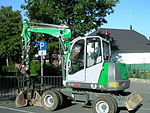
|
| Telescopic excavator | The telescopic excavator is a modification of the hydraulic excavator. It is similar in structure and performance, but has a telescopic boom instead of a rigid boom. With this component, the radius of action of the device is significantly increased compared to a device with a standard boom. |

|
Dredger
In contrast to the standing excavator, the excavator is only able to carry out its work by moving the entire machine. It is suitable for transports over short distances. Decisive for the economy of the transport are among other things the acceleration capacity, the final speed as well as the loading volume.
| Device type | description | image |
|---|---|---|
| Wheel loader | With the help of various attachments, this universal device can loosen, load and install soil and bulk goods and convey over medium distances. The attachments can be changed quickly with a quick-change device. Depending on the construction task, there is a wide range of wheel loader sizes and performance classes to choose from. The machine can either have a rigid frame with wheel steering or a split frame with articulated steering. A distinction is made between parallel and Z-kinematics for the bucket kinematics. The swivel shovel loader is a special design, the working equipment of which can be swiveled to both sides. |

|
| Backhoe loader | This multi-purpose device is a combination between a conventional hydraulic excavator and a wheel loader. This device, which is mainly used in trench and pipeline construction, is operated entirely from the driver's cab; the driver's seat can be rotated depending on the working direction. To improve stability, two hydraulic supports are attached to the rear. In addition, the backhoe device can be moved laterally with the aid of a slide. |

|
| Crawler loader | The crawler loader is similar to the bulldozer, but has a loading shovel at the front. A single or multi-tooth ripper can be arranged at the rear. The motor is located in the rear of the machine and serves as a counterweight to the load that is picked up. In contrast to the wheel loader, the crawler loader can be used in soils with little load-bearing capacity due to the low surface pressure of the crawler tracks. In addition, it can loosen and load densely packed soils better. |
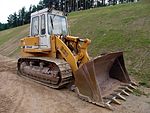
|
| Skid steer loader | The skid steer is used for similar tasks as a wheel loader, but can be used in a similar way to mini excavators due to its small external dimensions and low operating weight, even in very confined spaces or in buildings. A wide variety of attachments is also available for skid steer loaders, including equipment for goods handling, agriculture ( yard loader ), horticulture or cleaning purposes. |

|
Flat excavator
Flat excavators work in flat removal or application and some devices are partially designed for the transport of material over longer distances. As with the excavator, it is necessary to move the entire device for loosening and conveying. Flat excavators have a high engine power and sometimes reach medium to high top speeds.
| Device type | description | image |
|---|---|---|
| bulldozer | This construction device is suitable for leveling work and conveying soil over short distances. For this purpose, bulldozers in various sizes and performance classes have been developed. Depending on the requirements, different (leveling) blade types are available, and a single or multi-tooth ripper can be attached to the rear end. The chain drive is designed as a standard or as a delta drive. |
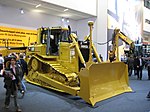
|
| Grader | The machine, also known as the earth or road planer, is optimized for precise grading work. The main shield (the coulter) can be hydraulically moved in a variety of ways (position, height, sideways swiveling) and, above all, is arranged in the middle under the vehicle with a long wheelbase, so that driving over uneven ground has significantly less effect than with a front shield. A combination of front axle and articulated steering means that most graders can work in crab steering and thus keep the subgrade free of marks. A front plate can be attached for pre-leveling, and a rear ripper for loosening solid floors. |

|
| Scraper | The scraper (also scrapers or scraper called) takes soil in Flachabtrag and this can economically support over long distances. Different types of trolleys can be used depending on the solvability of the floor. A distinction is made between the double-motor, elevator or snail scraper. In the case of particularly difficult to remove soils, a push caterpillar can push the scraper. A combination of two scrapers (so-called push-pull operation) or a trailed scraper is also possible. |

|
| Scraper | The scraper unites the function of scraper and bulldozer, which means it can loosen, load, convey and pave soil and level soil. The transport routes can extend over medium distances. The usability on soils with low bearing capacity or in bodies of water with shallow water is also advantageous. With a special wading device, the device can work down to a depth of 1.8 meters. |
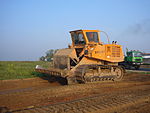
|
Suction dredger
Suction dredgers are mainly used in hydraulic engineering , e.g. for maintaining ports and shipping routes or in sand and gravel mining. Smaller models are also suitable for quick use in the area of underground supply lines. They have established themselves as a gentle excavation method for repair and renovation work. Instead of laborious physical work with a shovel and jackhammer, the soil is simply floated up and vacuumed. However, the effects on the local soil fauna are catastrophic.
Drilling and diaphragm wall devices
Special construction equipment is required for special civil engineering tasks, including the construction of diaphragm walls and bored piles . The devices take over the loosening of the soil and then convey it to the surface. In order to avoid collapsing in soils with little load-bearing capacity, the devices must adequately support the boreholes and diaphragm walls during manufacture. In addition, in the case of the bored pile, a pipe comes into question, in the case of the diaphragm wall, a support fluid.
| Device type | description | image |
|---|---|---|
| Rotary drilling rig | With the help of the rotary drilling rig, cased or uncased boreholes can be made in the ground and the resulting soil material can be brought to the surface. Subsequently, depending on the requirements, a reinforcement cage can be inserted and the bored pile concreted. If a pipe has been inserted to stabilize the borehole, it can be pulled gradually with the device during the concreting process ( contractor method ). The rotary drilling rig essentially consists of the so-called carrier device and the mast with rotary drive and Kelly bar. The soil can be loosened with a variety of tools. A distinction is made between drill grabs and augers as well as roller and drop weight chisels and down-the-hole hammers. A suitable drilling tool must be selected depending on the existing soil. Rotary drilling rigs are now almost exclusively powered by diesel engines. There are now also purely battery-electric (BEV) powered rotary drilling rigs. |

|
| Diaphragm wall grab | For the production of diaphragm walls, diaphragm wall grabs and diaphragm wall cutters are used. These devices, consisting of a carrier device and a rope grab or a rope milling machine, loosen the soil and bring it to the surface. A bentonite suspension circuit can be connected to the device to temporarily support the slot. The diaphragm wall cutter works in continuous operation, the diaphragm wall grab, on the other hand, works in cycle operation. |

|
Transport equipment
The horizontal transport of earth masses or bulk materials as well as machines or components is carried out with the help of various types of transport equipment. They are suitable for long haul distances, and most of them can deliver their load on their own. Various earthmoving machines are also suitable for transport over short and medium distances. Depending on the amount of material to be moved and the transport route (public road network or private property), different devices come into question. Another option, but not detailed here, is transport with rail vehicles in track operation as well as by ship.
| Device type | description | image |
|---|---|---|
| Construction site dump truck | This special form of the truck is street legal and can be constructed as a multi-axle tipper or tractor unit . A large number of designs and performance classes are available, the loading area can be emptied to the rear or to the side, depending on the version. The vehicle is loaded with the aid of stationary or mobile excavators, which extend over the side wall with their boom . |

|
| Gravity trucks | In contrast to conventional trucks, gravity trucks (also called SKW , dumpers or dump trucks ) are not approved for road use due to their dimensions and increased weight . The devices have powerful motors and, despite their weight, reach high speeds. The loading area of this device can only be emptied to the rear. Sufficiently large excavators are required to load the vehicles. |
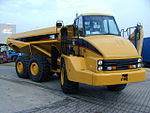
|
| Front tipper | The front tipper (also called dumpers , Japanese motorized vehicles , dump trucks or Muli ) can be used for transporting building materials on small construction sites and in gardening and landscaping . It has a shell-shaped loading area at the front that can be tilted if necessary. The driver's seat and the controls are located behind this loading area. Larger devices can be equipped with articulated steering and are also used in tunnel construction due to their maneuverability and compact dimensions. |

|
| Conveyor belt | The conveyor belt continuously transports material over both long and short distances. Depending on the version, the conveyor belt reaches different conveying speeds. The bulk goods must be sufficiently shredded so that there is space for them on the conveyor belt. Since the construction effort is quite high, conveyor belts are usually only suitable for transport tasks that have to be carried out over a longer period of time or in particularly difficult terrain. |
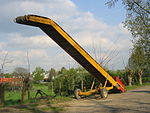
|
| Low loader | The low loader is used to transport construction equipment which, due to its size or weight, is not allowed to drive on public roads. It can also be used to transport components or auxiliary building materials. Several axles, which can also be steered separately, are arranged for better weight distribution. The low-loader is pulled by a truck or tractor unit . |

|
Machines for transporting and processing concrete and mortar
Concrete and mortar can be produced either in mobile mixing plants or in stationary mixing plants. A number of machines are available for transport to and from the construction site as well as for concrete processing.
| Device type | description | image |
|---|---|---|
| concrete mixer | Concrete mixers are used to produce fresh concrete. The components of the concrete (water, aggregate , cement and, if necessary, additives or concrete admixtures) are poured into the mixing container and mixed. In the mixing container there are mixing tools which, depending on the design, rotate around a vertical (plate mixer) or around one or two horizontal axes (trough mixer). The ready-mixed concrete is emptied through a floor opening. A distinction is made between game-wise and continuously working mixers. |

|
| Truck mixer | Truck mixers are used to transport the fresh concrete from the manufacturing plant to the installation site. A mixing drum with drive unit and loading and unloading device is mounted on a truck chassis. The drum can be rotated while driving to prevent the concrete from segregating. The truck mixers are street legal. Because of the axle loads to be observed , the number of vehicle axles increases with the capacity of the drum. Large truck mixers are usually designed as four-axle or five-axle vehicles and less often as semi-trailers. On the construction site, the concrete is conveyed into the formwork with a crane bucket or a concrete pump, rarely using a slide or a conveyor belt. |

|
| Truck mixer with conveyor belt | In Scandinavia, truck mixers with conveyor belts are also used to transport the fresh concrete from the manufacturing plant to the installation site. A mixing drum with drive unit and loading and unloading device, as well as a conveyor belt or a hydraulic telescopic slide, are mounted on a truck chassis. On the construction site, the concrete is conveyed into the formwork via a slide or a conveyor belt with remote control. These vehicles have proven to be a very flexible alternative in the past. | |
| concrete pump | With the concrete pump, fresh concrete is conveyed from the mixing plant or from the truck mixer to the installation site through a stationary pipe or a pipe attached to a flexibly adjustable placing boom. Depending on the design and performance class, there are different delivery rates and delivery distances. Concrete pumps can be manufactured as a vehicle body (truck-mounted concrete pump with placing boom) or as a stationary device (construction site concrete pump). Truck mixers can be combined with a concrete pump and a placing boom to form a truck mixer concrete pump . |

|
| Silo plate | The silo plate is a truck with a specially developed structure, which is responsible for the logistics solution to transport dry material silos. There are silo plates for pocket silos, hook lift silos, chain silos and picolo silos. | |
| Mortar pump | The mortar pump consists of a storage tank and the pumping unit. It is used to mix dry mortar with water and then pump it to the place of use. The dry mortar can be added as bagged goods or from a mortar silo. |

|
| Shotcrete equipment | The shotcrete device is operated either manually or by machine and is used to process shotcrete . Depending on whether the wet spraying process or the dry spraying process is used, the device is operated differently. Both spray methods require compressed air, which has to be generated with a compressor. |

|
| Concrete saw | Special concrete saws are used to separate and produce (dummy) joints in concrete. The release sheet is cooled with water. The main area of application of the concrete saw is in concrete road construction, since here the concrete ceiling has to be provided with longitudinal and transverse joints at fixed intervals in order to avoid uncontrolled cracks. |

|
| Rotary trowel | The rotary or power trowel smooths the surface of freshly made concrete floors and concrete pavements. There are both hand-held trowels and devices with a driver's seat. The devices can be easily steered in any direction during operation. Versions with one rotor blade or two rotor blades are possible. |

|
| Internal vibrator / external vibrator | Vibrators are used to compact fresh concrete. The inside of the machine is equipped with an imbalance and thus releases vibrations. The vibration stimulates the fresh concrete to move, which means that air can escape from the concrete and it can be stored more densely. Vibrators can be held in the component to be concreted during the concreting process (internal vibrator), or they can be attached to the formwork (external vibrator). |

|
Hoists
Lifting equipment is used for the vertical and horizontal transport of building materials and auxiliary building materials as well as people on construction sites. A distinction is made between mobile and stationary devices. The speed of assembly and the way the device is adapted to the construction progress plays a special role in the choice of device. The maximum possible lifting height and the load torque are also decisive for the choice of device .
| Device type | description | image |
|---|---|---|
| Tower crane | The tower crane has established itself as the standard hoist in building construction and is conceivable in many different types of construction. First of all, a distinction is made between a crane that rotates above or below, which can be equipped with a trolley, needle, telescopic or articulated jib. Furthermore, the device can be designed as a climbing crane and expanded as construction progresses. In order to reduce the construction effort, so-called quick assembly cranes were developed for small construction tasks. |

|
| Gantry crane | The gantry crane has two supports and can be moved on rails. The lifting process is done with a trolley. This device is often used in building yards or in precast factories, but can also be used in assembly structures or in halls. |

|
| Cable crane | The cable crane is related to the gantry crane, but it spans considerably longer distances. Components of the construction are a pendulum tower and a machine tower, which are connected by a suspension cable. There is a trolley on the carrying cable, which is controlled from the machine tower. The cable crane is particularly suitable for construction sites that are difficult to access or long, line-like construction sites such as dam or cable car construction sites . |

|
| Mobile crane | In contrast to the devices mentioned above, the mobile crane (also known as a car or mobile crane) can cover longer distances independently and, depending on the version, has a road approval (with the exception of large or crawler cranes). The chassis can be equipped with both wheel and caterpillar tracks. In order to improve stability during the lifting process, the side supports on the device must be extended. |
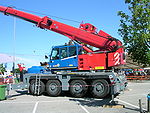
|
| Telescopic handlers | This universal device is reminiscent of a wheel loader, but is intended more for lifting loads. The telescopic boom can be extended and, depending on the requirements, can be fitted with various attachments. The telehandler is particularly suitable for frequently changing locations and low loads. |

|
| Construction elevator | For the vertical transport of people and goods during the construction period, construction elevators can be used, which are dismantled again at the end of the construction period. Different sizes and performance classes are possible. Since the elevator has to adapt to the construction progress, the construction can be expanded upwards. |

|
| Mini crane | Mini cranes are suitable for light lifting operations over short distances. They were developed for rational and health-friendly masonry. The mini cranes have a wheel drive and are controlled with a remote control. |

|
| Working platform | This device is suitable for the vertical transport of people at workplaces that are difficult to access at heights. It can also be controlled from the platform and can be provided with lateral supports to stabilize its position. |

|
| Aerial work platform | This device is suitable for the horizontally offset vertical transport of people at heights that are difficult to access and is mounted on trailers or chassis (frames) of trucks or wheeled excavators . It is controlled from the workman basket and has supports that can be extended to the side. At the bottom there is an emergency control unit for the recovery of broken down devices. |

|
| Pulley | This hoist, which has been known since ancient times, simplifies the lifting of loads with little machine effort. It is used today for smaller lifting operations, where the above-mentioned machines cannot be used either for reasons of space or for economic reasons. It can be equipped with an electric motor. |

|
Pile-driving and pulling equipment
In order to create a sheet pile wall or a pile wall , devices for ramming and vibrating sheet piling and steel profiles are required. These devices are connected to a carrier device (usually a crawler excavator). The choice of the right device depends on the prevailing ground conditions as well as the requirements regarding noise protection and the maximum permissible vibrations.
| Device type | description | image |
|---|---|---|
| ram | With the help of the ram, sheet piling and steel girders can be inserted into the ground or pulled out of it. The drive of the ram can be designed in various ways. A distinction is made between steam rams , diesel rams , compressed air rams , explosion rams and vibration rams . The ram consists of the carrier or basic device and the actual ram. |

|
Devices in traffic route construction
The special requirements for high quality asphalt and concrete road construction are met by specially developed equipment for processing and compacting mixed asphalt and fresh concrete. Different types of rollers are used to remove the cavities in the asphalt.
| Device type | description | image |
|---|---|---|
| Paver finisher | For the production of asphalt pavements, built-in devices have been developed that pick up the fresh mix and distribute and pre-compact it over the set width. To do this, the truck pushed by the built-in device puts the mix in the receptacle. Both crawler and wheel drives are used. |

|
| Compact asphalt paver | Special form of the black paver with crawler chassis. Developed by the Kirchner and Vögele companies, it combines two built-in devices in one machine and enables the binder and surface layers to be produced “hot on hot” in one operation. This type is sold in series by Dynapac and is known as compact asphalt paver. The process later developed as an alternative by the Vögele company is called InLine Pave and uses two separate vehicles. The paver moves on the pre-compacted binder course. In both variants, the mixed material feed is always carried out with a feeder due to the use of a material container with a larger capacity.
The picture shows the Dynapac variant with a feeder in front of it. |

|
| Spray paver | Another special form of the black paver. Equipped with a storage tank with a spray system for bitumen emulsions, this type is used for thin layers in hot paving and for conventional paving with pre-spraying. In order to increase the low emulsion supply, there are tank inserts for the material container. The mix is then supplied with a feeder. |

|
|
Concrete slab paver Slipform paver Concrete slab slipform paver |
Similar to the black paver, the concrete paver creates roadways, but from the building material concrete. Modern slipform pavers are larger and are divided into several work stations. First, the fresh concrete is roughly distributed over the length to be laid by the machine. In the next step, the surface is peeled off according to the profile and the anchors and dowels are inserted. In the last step, the surface is finally smoothed.
Slipform pavers tailored to the process are also used for the installation of monolithic profiles (kerbstone profiles, concrete slide protection walls or gutters) using the offset method. |

|
| Bridge paver | Bridge pavers are used by the construction industry to produce straight, sloping or curved surfaces from gravel, concrete or asphalt. These types are primarily used in the construction of steep wall curves and in canal and dam sealing in hydraulic engineering. The material to be installed is removed by a deformable screed with displacement-controlled hydraulic cylinders. Specially modified rollers are used for redensification. |

|
| Road milling machine | Milling machines are used to remove asphalt or concrete layers in roadways. The milling machine consists of a rotating milling drum in the middle or rear area. The pavement layer is milled off by the milling drum and, in the case of larger machines, the milled material is loaded onto a truck traveling with it by means of a conveyor belt. A distinction is made between hot milling machines and cold milling machines . |

|
| Tricycle roller | A three-wheel roller can be used to compact a freshly paved asphalt layer. In this case, compression takes place via the weight of the device. The “wheels” of the roller are called bandages and have a smooth surface. Built-in tanks can be filled with water to increase the weight. During the paving of bitumen-bound mix, the water is used to moisten the drums. |

|
| Pneumatic tire roller | Similar to the mode of operation of a static roller, fresh asphalt mix is compacted with a pneumatic tire roller due to the weight of the device. However, this machine has wheels with pneumatic tires, the air pressure of which can be adjusted during the rolling process. The design of the rubber-tyred roller "kneads" the surface and thus closes the pores in the asphalt surface. |

|
| Combination roller | Combination rollers combine the compaction effect of a pneumatic tire roller and a tandem vibration roller in one device. They are primarily used when paving asphalt concrete pavements. |
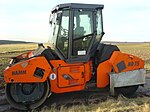
|
| Tandem vibratory roller | In contrast to the rollers mentioned above, compaction with a tandem vibration roller (also known as a tandem roller) takes place through dynamic movement processes in the drums. The drums are set in vibration with the help of an imbalance and pass this on to the uncompacted asphalt layer. You can work both forwards and backwards and have a sprinkler system to wet the drums with water. A gravel spreader can be attached at the rear to dull the surface of the asphalt. |

|
| Ramp sprayer | The ramp sprayer is used to apply binding agents to roadways. The machine consists of the basic truck unit and a storage tank with heating options as well as a spray bar that is adjustable in height and width at the rear. Its controlled activation of the spray bar and the individual nozzles takes place from the driver's cab. A manual operating device is arranged on a work platform above the spray boom. |
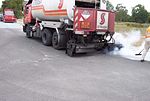
|
| Banquet paver | The banquet pavers represents the banquet ago by roads. It has a wheel drive and is supplied with shoulder material from a truck at its front. Inside the machine, a conveyor belt and a screw bring the material to the installation device. This device builds the shoulder material in the specified width and ensures precompaction. |

|
| Feeder | A feeder serves as a contactless connection element between the paver and the mix transport vehicles. Originally developed for compact asphalt pavers, normal road pavers can also be fed with the conveyor belt. With a large material container, it ensures a constant supply of mix for the paving paver. |
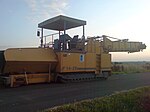
|
| Paving machine | The paving machine simplifies the laying of large pavement areas thanks to a stone pick-up device on the front part of the vehicle, which places a larger number of paving stones at the same time. |

|
| Soil stabilizers | The soil stabilizer (also known as a tiller ) improves soils that are not or poorly stable by mixing in stabilizing additives (e.g. lime). In the middle of the device is the tiller, which mixes lime into the soil, which is then compacted by means of a vibratory roller. |

|
| Binder spreader | The binding agent spreader is required in the course of a soil improvement or soil consolidation in order to spread the required amount of hydraulic binding agent dosed on the subgrade. |
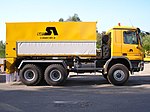
|
| Cold mixing plant | The cold mixing plant is mainly used for the production of hydraulically bound base courses and for cold recycling. This process is also known as the central mixing process. |

|
| Mastic asphalt stove | The mastic asphalt cooker is used to warm up mastic asphalt and transport it to the installation site. |

|
| Mastic asphalt plank | The mastic asphalt plank is used to pave mastic asphalt mechanically and thus to be economical even for large construction projects. The working method is similar to that of a concrete paver, but without compaction. |
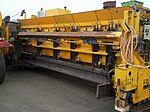
|
| Water truck | Water trucks are used in earthworks and traffic route engineering to water large areas. This is done to reduce dust formation or to add a certain amount of water to the soil (optimal water content for soil improvement). |
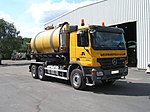
|
| Heating machine | With the help of the heating machine, asphalt pavements are gently heated over a large area. This is particularly necessary when old or damaged traffic areas are to be repaired using the hot recycling process. However, it is also suitable for drying and preheating documents. |

|
| Hot recycler | Hot recyclers are used to rehabilitate asphalt surface courses (so-called hot recycling process). In this process, 100% of the surface layers are reused and missing materials such as grit or bitumen are added. |

|
Sewer and pipeline construction equipment
Special devices have been developed for construction tasks in sewer and pipeline construction, which on the one hand guarantee occupational safety and also enable economical operation. In addition to the bones mentioned below, compaction equipment or excavators are also often used.
| Device type | description | image |
|---|---|---|
| Trencher | The trencher is equipped with a crawler chassis and serves as a continuously working earthmoving device. Due to its small excavation width, its main area of application is in trench or cable construction. Use is economical if there are no disruptive cross lines to hinder work. The milled material is ejected to the side. The trench cutter is suitable for soils that are easy to medium-difficult to remove. |

|
| Installation device | With the help of the shoring device, trenches can be safely supported. The device is lifted into the trench with a hoist or an excavator and is used there to stiffen the trench walls. Depending on the trench depth and width, different shoring devices are to be used. |

|
| Weld bead | The welding bead takes over welding work in difficult terrain. Their area of application is in pipeline construction. Different performance classes are available depending on the requirements. |

|
| Pipelayer | The pipelayer is a crawler crane specially designed for laying pipelines. The crane boom is attached to the side of this device so that the machine can stand next to the trench and lower the pipeline there. |

|
| Horizontal drilling machine | This machine enables conduits and cables to be laid without digging a trench. For this purpose, the machine first drills a pilot tunnel to the target shaft using the soil displacement method and then carries out an expansion hole. The advantage of this device is the quick and reliable construction of pipelines, even if there are limits to the drilling diameter and soil class. |

|
Compaction equipment
Sufficiently compacted soils form the basis for permanent and stable structures and traffic routes. With the help of the compaction equipment, pore spaces in the soil, which are filled with air and water, are reduced, thus increasing the load-bearing capacity and reducing subsequent settlement. The compaction method depends on the type of soil. A distinction is made between cohesive and non-cohesive soils . Cohesive soils are to be compacted by kneading and rolling movements, while non-cohesive soils are to be compacted by dynamic movement processes.
| Device type | description | image |
|---|---|---|
| Single drum roller | Single drum rollers are used for large-area compaction work in earthworks. They have a roller with smooth or sheepfoot bandage at the front and conventional pneumatic tires at the rear. There is an articulated joint underneath the cab . The compression is achieved through the vibration work of the drum, which can be set in two frequencies. These devices are currently being equipped with a large number of electronic compaction control systems (so-called area - wide dynamic compaction control ). With this system, the compaction performed is documented and displayed in relation to the area. |
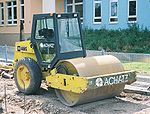
|
| Vibratory tamper | The hand-operated vibratory rammer is suitable for small compaction tasks. A gasoline or diesel engine drives a multi-spring oscillating system and this transfers the force to the tamping plate. Due to its good compaction performance and its small working width, the vibratory rammer is often used in narrow trenches. |

|
| Vibration plate | This device consists of a vibration plate that is connected to an unbalance oscillator , which in turn is driven by a diesel or gasoline engine. The device is hand-held and has either only one forward movement (one direction of movement) or one forward and reverse movement (two directions of movement). Various device sizes can be selected depending on the compaction task. |

|
| Duplex roller | The duplex roller is positioned between the vibratory plate and the compactor in terms of performance and size. It is also hand-held and has one or two vibrating smooth-coated bandages. |

|
| Trench roller | The trench roller is intended for use in narrow trenches. This device is a further development of the vibratory roller. The four independently driven sheep's foot bandages are particularly suitable for cohesive soils. It is operated with an infrared remote control, since the operator does not have to be in the trench, where he is exposed to an increased risk of accidents as well as exhaust gas and noise emissions. |

|
| Plate compactor | Plate compactors are used to compact unbound layers of gravel or crushed stone. The plate compactor is particularly suitable for compacting fine levels. |

|
Tunneling equipment
Depending on the existing soil and the groundwater conditions, machines and construction methods are selected for driving a tunnel. Another criterion to be mentioned is the shape of the tunnel cross-section. Essentially, a distinction is made in tunneling between shield driving , partial cut driving or mining using blasting (also known as the New Austrian Tunneling Method ).
| Device type | description | image |
|---|---|---|
| Shield tunneling device | Shield tunneling devices absorb the radial pressures of the ground and thus enable safe work in the protection of the shield. A distinction is made between different shields, which are selected depending on the soil and water conditions. In the case of easily detachable soils and a lack of water, a shield drive with a tearing and loading shovel is chosen. A blade with a cutting wheel is used for more complex soil and water conditions. In this case, a distinction is made between the hydroshield, the mixshield and the earth pressure shield. The tunnel tubes are supplied with compressed air to prevent water ingress. |
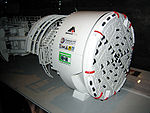
|
| Roadheading machine | The roadheading machine is suitable for the construction process using the partial cut method. The device has a crawler track and a telescopic and swiveling boom. A rotating milling head (round shank bit) is attached to the boom. A pick-up device is attached below the milling head, which picks up the excavated material and brings it to the rear of the machine via a conveyor belt. There the material then falls into a transport vehicle. |

|
| Drill rig | With the help of the drill carriage, holes are drilled into the face during blasting, into which the explosive charges can then be introduced. The device drives to the place of use with pneumatic tires and is operated from the driver's cab. The holes are drilled using a number of drilling rigs. |

|
| Tunnel excavator | The tunnel excavator has been specially designed for the cramped working conditions in tunnels and works similarly to a conventional hydraulic excavator with a crawler track. The boom kinematics are extremely space-saving, so that all work processes can be carried out in the tunnel. |

|
Compressor devices
On construction sites, compressed air is used for hand-held demolition hammers, drilling equipment and spraying equipment as well as for compressed air support in tunnel construction. Depending on the volume flow required, different compressor sizes are used on the construction site to generate compressed air.
| Device type | description | image |
|---|---|---|
| Construction compressor | The construction compressor is suitable for generating compressed air. The device consists of a motor, which is used to compress air via compressor screws. With mobile devices, the motor is mounted on a single-axle chassis. Larger stationary devices, on the other hand, are container bodies. The compressed air is generated by means of a double screw, which compresses the incoming air while the screw is turned. |
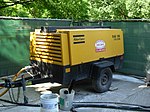
|
Cleaning equipment
Special devices are used to clean construction sites.
| Device type | description | image |
|---|---|---|
| sweeper | Sweepers are used to pick up loose dirt such as sand, earth, milled material and dust. They are used to clean construction sites after the construction work is finished. They are also used to clean the road surface in road construction when a new layer of asphalt is to be applied to the road surface. |
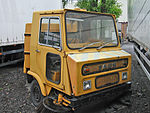
|
See also
- List of forestry equipment and machines
- List of agricultural implements and machines
- List of construction machinery manufacturers
- Bauma (fair)
- Construction equipment operator
- Mechanic for agricultural and construction machinery
literature
- Horst König, Bernd Kochendörfer, Fritz Berner (eds.): Machines in construction: Basics and application. 3. Edition. Teubner, Stuttgart 2011, ISBN 978-3-8348-0953-7 .
- Gerhard Drees: Construction machinery and construction methods. Expert-Verlag, 2002, ISBN 3-8169-2060-8 .
- Günter Kunze: Construction machinery. Vieweg Verlag, 2002, ISBN 3-528-06628-8 .
- Francis Pierre: Fascination with construction machinery. Giesel Verlag, 1998, ISBN 3-9802942-8-5 .
Web links
- Comprehensive knowledge portal about construction and building material machines at www.baumaschine.de
- Special foundation engineering equipment - bauma technical report, TU Dresden knowledge portal
- Life cycle management of construction machinery, knowledge portal TU Dresden
- Traction of chain-guided construction machines, knowledge portal TU Dresden
- BGR 500 - Changes to work in the danger area, TU Dresden knowledge portal (PDF; 0 kB)
Individual evidence
- ↑ LB 16 unplugged rotary drilling rig. Liebherr , accessed on July 28, 2019 .
- ↑ Large rotary drilling rig | SUNCAR HK AG. Retrieved July 28, 2019 .
